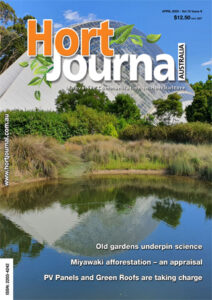
What is new in horticulture?
The discovery of a new species of orchid in Japan underscores the necessity of persistent exploration and conservation efforts for undisturbed native ecosystems.
The orchid, named Spiranthes hachijoensis, was discovered in Tokyo. This discovery will undoubtedly spark interest in the flower which was originally thought to be S. australis, the only orchid thought to grow on the Japanese mainland. It will be interesting to follow the development of this orchid and how much interest it will generate.
Always looking for something new, some Australian growers are using European plant trials to provide plants that may suit the Australian climate. My credit card is waiting for the possibility of finding something new. I am cautious however to make sure that whatever I plant does not escape into the wild and become a nuisance.
For very disturbed ecosystems such as intensively farmed, contaminated, or mined land, a body of research has focused on growing plants bigger, faster – particularly now that carbon credits could be a source of income. Often, new plantations of trees are planted in areas where the local environment has been degraded, at times extremely. A researcher from Eidgenössische Technische Hochschule Zürich (ETH) is working on the premise that in order for a forest to thrive, the underground network of fungi and soil bacteria must form a symbiotic relationship where mycorrhizal fungi help roots access nutrients in exchange for carbohydrates produced by the trees. The team from ETH Zurich sequence the DNA from intact forests hoping to add similar compositions of microbes to newly planted trees. Just planting a tree and adding random fungus is no guarantee of success. By sampling the soil microbiome of many sites, researchers hope to identify the best growth conditions for a particular type of plantation.
Trials have started in Georgia, USA, and preliminary results should be available by the end of t2023. Team Leader, Dr Colin Averill, hopes to increase productivity by up to 70% where similar methods used in a research plot in Wales showed gains between 30 to 70%. Sourcing the soil could be a challenge as many species of fungi cannot be cultured, so there is a risk that harvesting soil could degrade the collection site. Using information encoded in deoxyribonucleic acid (DNA) crops up in in many fields of research. Researchers use it to identify and classify many types of living tissue and to modify some plant attributes. Genetic modification could give a plant new characteristics, such as changing the way it grows and adding resistance to a particular disease.
Phytophthera cinnamomi and Austropuccinia psidii, two aggressive plant pathogens, have a new enemy. Greenlife Industry Australia is supporting research by the University of Queensland into an RNA (ribonucleic acid) based treatment for Australian natives, and commercial crops such as pineapple.
RNA is essential for all living cells. This form of plant treatment is like a vaccine and protects plants by triggering their natural defences. RNA based vaccines do not alter the DNA and the characteristics that make the plant attractive.
Various methods of vaccine delivery investigated by the researchers at University of Queensland include BioClay™, also developed at the University of Queensland, foliar sprays, trunk injections, and root drench for hydroponic systems.
Enjoy the read!
Karen Smith and your Hort Journal Team
